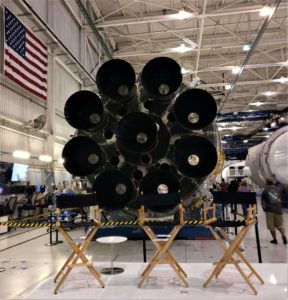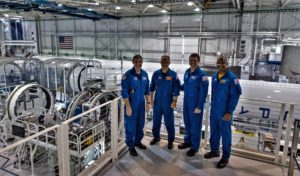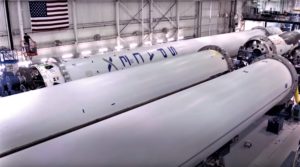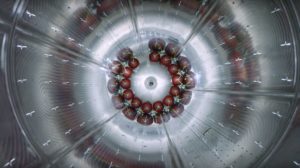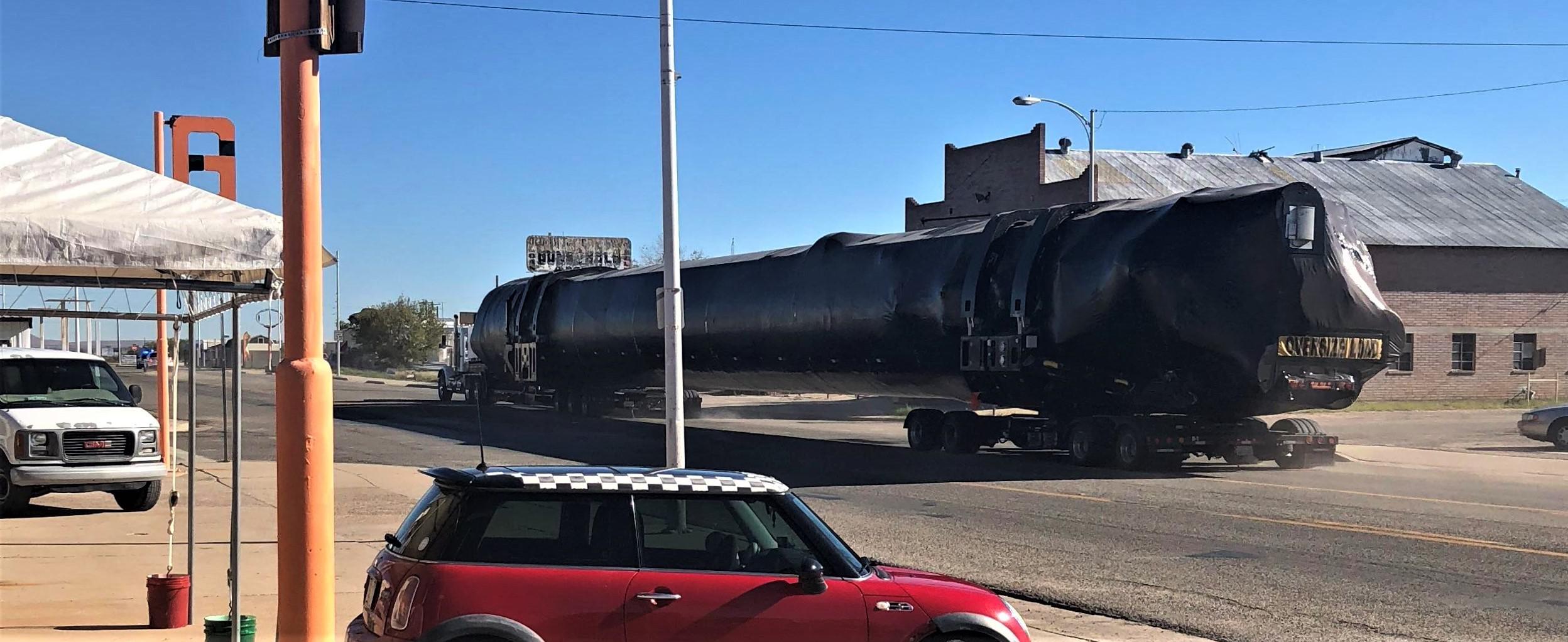

SpaceX
SpaceX hot-fires Crew Dragon’s Falcon 9 as separate rocket spied in Arizona
A SpaceX Falcon 9 booster has been spotted traveling eastbound through Wilcox, AZ, indicating a shipment from the company’s Hawthorne, CA rocket factory to its McGregor, TX facilities for hot-fire acceptance testing.
Captured by Reddit user codercotton on October 28th, this first stage (S1) is headed to Texas at the same time as SpaceX’s facilities appear to be wrapping up an extended test campaign with the Falcon 9 rocket stages that will launch an uncrewed Crew Dragon on the upgraded spacecraft’s first trip into orbit.
The team at our rocket development facility in McGregor, Texas completed a static fire test last night of the Falcon 9 booster that will launch SpaceX’s first demonstration mission for @NASA’s Commercial Crew Program – one step closer to flying astronauts to the @Space_Station! pic.twitter.com/iDYNoamCvU
— SpaceX (@SpaceX) October 27, 2018
This duo of Falcon 9 appearances highlights an unusual few months of what is often called “core spotting” by close followers of SpaceX. Typically, SpaceX ships and hot-fire tests a Falcon 9 booster every month, give or take roughly two weeks. It’s clear, however, that the imminent start of Crew Dragon launches under NASA’s Commercial Crew Program (CCP) has created some unique requirements with respect to both booster, upper stage, and individual engine testing in Texas.
For example, Falcon 9 B1051 – a new booster assigned to Crew Dragon’s first uncrewed demonstration launch (DM-1) – appears to have been testing in McGregor for the better part of three months, apparently including multiple hot-fire tests of the rocket. Prior to Commercial Crew, a nominal round of acceptance testing in McGregor would be expected to last between two and four weeks between arrival and departure. As such, spending three months or more in McGregor is very unusual, particularly for a brand-new booster like B1051.
B1051’s extended period of testing can likely be traced back to two main factors. At a more technical level, B1051 could be the first Falcon 9 Block 5 booster to have SpaceX’s upgraded COPVs (carbon-overwrapped pressure vessels) – bottles designed to hold helium and nitrogen at pressures around 5000 psi (35 MPa) – fully integrated on both the first and second stages. Perhaps not a major technical hurdle for SpaceX, this milestone is undoubtedly one of NASA’s most myopic and obsessive mountains-out-of-molehills in terms of the intense ‘certification’ burdens dumped on SpaceX over the course of CCP. SpaceX has apparently spent at least 1.5 years systematically designing, testing to destruction, and redesigning an in-house COPV, to the extent that CEO Elon Musk described the updated design as “by far the most advanced pressure vessel ever developed by humanity … It’s nuts.”
- In mid-September, CEO Elon Musk presented an update to BFR in front of Falcon 9 B1054 and at least three other visible boosters. (Eric Ralph)
- SpaceX’s NASA astronauts pose in front of the main Falcon assembly line, September 2018. (SpaceX)
- An October 2018 NASA video included this brief glimpse of SpaceX’s assembly line. (SpaceX)
- Falcon 9 shows off some of its COPVs in a tour of SpaceX’s Hawthorne factory. (SpaceX)
Juggling Falcon 9 tests
Despite the extreme lengths of testing apparently required for the Falcon 9s that will launch Crew Dragon, it can be concluded with some certainty that SpaceX has still managed to fit in normal tests of a number of non-Crew boosters, upper stages, and Merlins. According to the above SpaceX tweet, B1051 is clearly still in Texas and is unlikely to leave for Florida until November (several days are needed to prepare a booster for transport). However, a different booster was spotted heading from California to Texas just this morning.
Further, Falcon 9 booster B1054 – nearly complete and stationed in front of the only real exit route – was spotted in SpaceX’s Hawthorne factory in mid-September, while an unknown first stage was caught departing the factory for Texas roughly two weeks later. Finally, at the same time as the mystery booster was being trucked to Texas, an even more mysterious Falcon 9 – visibly sooty and thus flight-proven – was spotted inside one of SpaceX Hawthorne’s separate refurbishment hangars, with at least three Merlins removed from its octaweb. Perhaps this is somehow related to the Falcon 9 booster (missing four of nine Merlins) headed East on October 28th.
Finally, according to a member of the /r/SpaceX subreddit, a separate Falcon 9 booster apparently arrived at SpaceX’s Vandenberg, CA launch facilities on October 26th, perhaps Falcon 9 B1046.3 preparing to launch for the third time for Spaceflight’s SSO-A rideshare mission, NET November 19.
https://twitter.com/_TomCross_/status/1048483536917823488
As with most things SpaceX, definitive answers are exceedingly rare when it comes to day-to-day operations like Falcon 9 transportation and even official confirmation of the particular boosters involved with any given launch. Understandably, these more esoteric details are probably treated as “need-to-know” only, and while I and many others would love to know, we certainly don’t *need* to know.
For prompt updates, on-the-ground perspectives, and unique glimpses of SpaceX’s rocket recovery fleet check out our brand new LaunchPad and LandingZone newsletters!
News
SpaceX launches Ax-4 mission to the ISS with international crew
The SpaceX Falcon 9 launched Axiom’s Ax-4 mission to ISS. Ax-4 crew will conduct 60+ science experiments during a 14-day stay on the ISS.

SpaceX launched the Falcon 9 rocket kickstarting Axiom Space’s Ax-4 mission to the International Space Station (ISS). Axiom’s Ax-4 mission is led by a historic international crew and lifted off from Kennedy Space Center’s Launch Complex 39A at 2:31 a.m. ET on June 25, 2025.
The Ax-4 crew is set to dock with the ISS around 7 a.m. ET on Thursday, June 26, 2025. Axiom Space, a Houston-based commercial space company, coordinated the mission with SpaceX for transportation and NASA for ISS access, with support from the European Space Agency and the astronauts’ governments.
The Ax-4 mission marks a milestone in global space collaboration. The Ax-4 crew, commanded by U.S. astronaut Peggy Whitson, includes Shubhanshu Shukla from India as the pilot, alongside mission specialists Sławosz Uznański-Wiśniewski from Poland and Tibor Kapu from Hungary.
“The trip marks the return to human spaceflight for those countries — their first government-sponsored flights in more than 40 years,” Axiom noted.
Shukla’s participation aligns with India’s Gaganyaan program planned for 2027. He is the first Indian astronaut to visit the ISS since Rakesh Sharma in 1984.
Axiom’s Ax-4 mission marks SpaceX’s 18th human spaceflight. The mission employs a Crew Dragon capsule atop a Falcon 9 rocket, designed with a launch escape system and “two-fault tolerant” for enhanced safety. The Axiom mission faced a few delays due to weather, a Falcon 9 leak, and an ISS Zvezda module leak investigation by NASA and Roscosmos before the recent successful launch.
As the crew prepares to execute its scientific objectives, SpaceX’s Ax-4 mission paves the way for a new era of inclusive space research, inspiring future generations and solidifying collaborative ties in the cosmos. During the Ax-4 crew’s 14-day stay in the ISS, the astronauts will conduct nearly 60 experiments.
“We’ll be conducting research that spans biology, material, and physical sciences as well as technology demonstrations,” said Whitson. “We’ll also be engaging with students around the world, sharing our experience and inspiring the next generation of explorers.”
SpaceX’s Ax-4 mission highlights Axiom’s role in advancing commercial spaceflight and fostering international partnerships. The mission strengthens global space exploration efforts by enabling historic spaceflight returns for India, Poland, and Hungary.
News
Starlink Cellular’s T-Mobile service to grow with third-party app data
From Oct 2025, T-Satellite will enable third-party apps in dead zones! WhatsApp, X, AccuWeather + more coming soon.

Starlink Cellular’s T-Mobile service will expand with third-party app data support starting in October, enhancing connectivity in cellular dead zones.
T-Mobile’s T-Satellite, supported by Starlink, launches officially on July 23. Following its launch, T-Mobile’s Starlink Cellular service will enable data access for third-party apps like WhatsApp, X, Google, Apple, AccuWeather, and AllTrails on October 1, 2025.
T-Mobile’s Starlink Cellular is currently in free beta. T-Satellite will add MMS support for Android phones on July 23, with iPhone support to follow. MMS support allows users to send images and audio clips alongside texts. By October, T-Mobile will extend emergency texting to all mobile users with compatible phones, beyond just T-Mobile customers, building on its existing 911 texting capability. The carrier also provides developer tools to help app makers integrate their software with T-Satellite’s data service, with plans to grow the supported app list.
T-Mobile announced these updates during an event celebrating an Ookla award naming it the best U.S. phone network, a remarkable turnaround from its last-place ranking a decade ago.
“We not only dream about going from worst to best, we actually do it. We’re a good two years ahead of Verizon and AT&T, and I believe that lead is going to grow,” said T-Mobile’s Chief Operating Officer Srini Gopalan.
T-Mobile unveiled two promotions for its Starlink Cellular services to attract new subscribers. A free DoorDash DashPass membership, valued at $10/month, will be included with popular plans like Experience Beyond and Experience More, offering reduced delivery and service fees. Meanwhile, the Easy Upgrade promotion targets Verizon customers by paying off their phone balances and providing flagship devices like the iPhone 16, Galaxy S25, or Pixel 9.
T-Mobile’s collaboration with SpaceX’s Starlink Cellular leverages orbiting satellites to deliver connectivity where traditional networks fail, particularly in remote areas. Supporting third-party apps underscores T-Mobile’s commitment to enhancing user experiences through innovative partnerships. As T-Satellite’s capabilities grow, including broader app integration and emergency access, T-Mobile is poised to strengthen its lead in the U.S. wireless market.
By combining Starlink’s satellite technology with strategic promotions, T-Mobile is redefining mobile connectivity. The upcoming third-party app data support and official T-Satellite launch mark a significant step toward seamless communication, positioning T-Mobile as a trailblazer in next-generation wireless services.
News
Starlink expansion into Vietnam targets the healthcare sector
Starlink aims to deliver reliable internet to Vietnam’s remote clinics, enabling telehealth and data sharing.

SpaceX’s Starlink expansion into Vietnam targets its healthcare sector. Through Starlink, SpaceX seeks to drive digital transformation in Vietnam.
On June 18, a SpaceX delegation met with Vietnam’s Ministry of Health (MoH) in Hanoi. SpaceX’s delegation was led by Andrew Matlock, Director of Enterprise Sales, and the discussions focused on enhancing connectivity for hospitals and clinics in Vietnam’s remote areas.
Deputy Minister of Health (MoH) Tran Van Thuan emphasized collaboration between SpaceX and Vietnam. Tran stated: “SpaceX should cooperate with the MoH to ensure all hospitals and clinics in remote areas are connected to the StarLink satellite system and share information, plans, and the issues discussed by members of the MoH. The ministry is also ready to provide information and send staff to work with the corporation.”
The MoH assigned its Department of Science, Technology, and Training to work with SpaceX. Starlink Vietnam will also receive support from Vietnam’s Department of International Cooperation. Starlink Vietnam’s agenda includes improving internet connectivity for remote healthcare facilities, developing digital infrastructure for health examinations and remote consultations, and enhancing operational systems.
Vietnam’s health sector is prioritizing IT and digital transformation, focusing on electronic health records, data centers, and remote medical services. However, challenges persist in deploying IT solutions in remote regions, prompting Vietnam to seek partnerships like SpaceX’s.
SpaceX’s Starlink has a proven track record in healthcare. In Rwanda, its services supported 40 health centers, earning praise for improving operations. Similarly, Starlink enabled remote consultations at the UAE’s Emirati field hospital in Gaza, streamlining communication for complex medical cases. These successes highlight Starlink’s potential to transform Vietnam’s healthcare landscape.
On May 20, SpaceX met with Vietnam’s Ministry of Industry and Trade, announcing a $1.5 billion investment to provide broadband internet, particularly in remote, border, and island areas. The first phase includes building 10-15 ground stations across the country. This infrastructure will support Starlink’s healthcare initiatives by ensuring reliable connectivity.
Starlink’s expansion in Vietnam aligns with the country’s push for digital transformation, as outlined by the MoH. By leveraging its satellite internet expertise, SpaceX aims to bridge connectivity gaps, enabling advanced healthcare services in underserved regions. This collaboration could redefine Vietnam’s healthcare infrastructure, positioning Starlink as a key player in the nation’s digital future.
-

 Elon Musk3 days ago
Elon Musk3 days agoTesla investors will be shocked by Jim Cramer’s latest assessment
-

 News1 week ago
News1 week agoTesla Robotaxi’s biggest challenge seems to be this one thing
-

 News2 weeks ago
News2 weeks agoTexas lawmakers urge Tesla to delay Austin robotaxi launch to September
-

 Elon Musk2 weeks ago
Elon Musk2 weeks agoFirst Look at Tesla’s Robotaxi App: features, design, and more
-

 Elon Musk2 weeks ago
Elon Musk2 weeks agoxAI’s Grok 3 partners with Oracle Cloud for corporate AI innovation
-

 News2 weeks ago
News2 weeks agoSpaceX and Elon Musk share insights on Starship Ship 36’s RUD
-

 News2 weeks ago
News2 weeks agoWatch Tesla’s first driverless public Robotaxi rides in Texas
-

 News2 weeks ago
News2 weeks agoTesla has started rolling out initial round of Robotaxi invites

